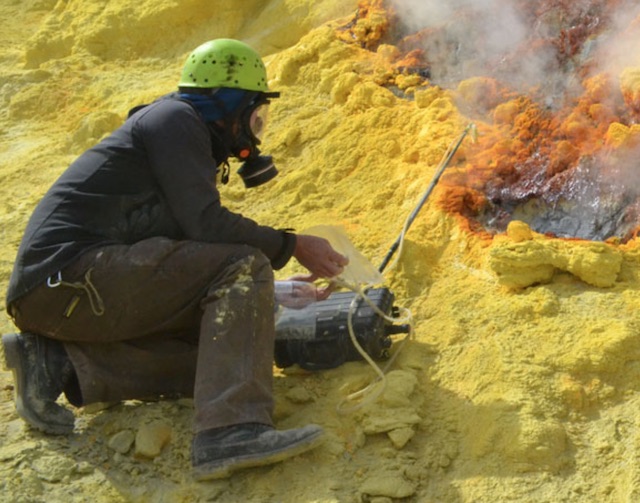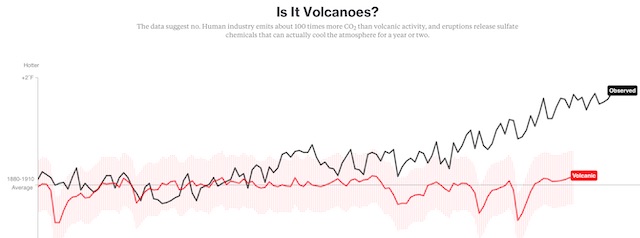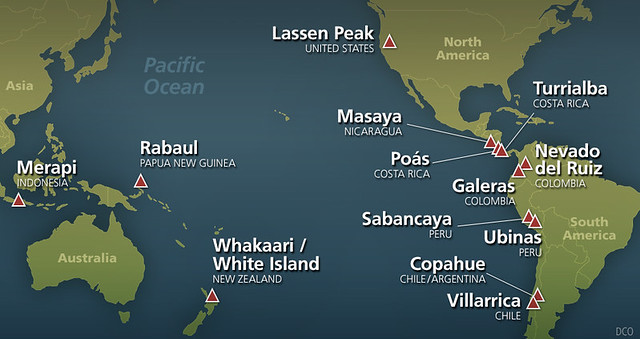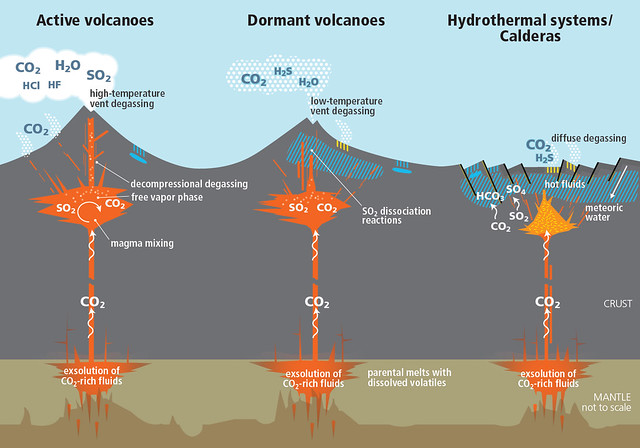
A new set of papers by a group of scientists involved in a 10 year study of volcanoes has advanced our knowledge of the deep earth.
Highlights
Key insights include …
- Amount of CO2 from Volcanoes: CO2 emitted by volcanoes each year is estimated at 280 to 360 million tonnes (0.28 to 0.36 Gt) per year
- This number includes CO2 vented into the oceans from the mid-ocean ridges
- To put that in context, our annual carbon emissions through the burning of fossil fuels and forests, etc., are 40 to 100 times greater than all volcanic emissions.
- A rather popular climate denialism talking point is to claim Volcanoes as an explanation. This latest data rather robustly debunks that assertion.
- The amount of Carbon: Just two-tenths of 1% of Earth’s total carbon—about 43,500 gigatonnes (Gt)[1]—is above surface in the oceans, on land, and in the atmosphere. The rest is subsurface, including the crust, mantle and core—an estimated 1.85 billion Gt in all.
- Eruption Early Warning: A shift in the composition of volcanic gases from smelly (akin to burnt matches) sulphur dioxide (SO2) to a gas richer in odorless, colorless CO2 can be sniffed out by monitoring stations or drones to forewarn of an eruption—sometimes hours, sometimes months in advance.
- Eruption early warning systems with real-time monitoring are moving ahead to exploit the CO2 to SO2 ratio discovery, first recognized with certainty in 2014
- The deep carbon cycle: The long-term stability of our atmospheric CO2, has been punctuated by large disturbances, including immense, catastrophic releases of magma that occurred at least five times in the past 500 million years.
- During these events, huge volumes of carbon were outgassed, leading to a warmer atmosphere, acidified oceans, and mass extinctions
- 66 million years ago: the Chicxulub bolide strike on Mexico’s Yucatan peninsula, released between 425 and 1,400 Gt of CO2.
- This rapidly warmed the planet and coincided with the mass (>75%) extinction of plants and animals—including the dinosaurs
Note that the day the dinosaurs died was the day that 425 and 1,400 Gt of CO2 was pumped into the atmosphere. This rapidly warmed planet and resulted in a global mass extinction event.
Guess the amount of CO2 we have generated since 1850?
We are already in the same league and have emitted about 850 Gt of CO2. The planet is already responding to this, and will continue to do so until it finds a new balance.
Australian researchers Balz Kamber and Joseph Petrus …
large bolide impacts are comparable to those observed in the Anthropocene in terms of rapidly disrupting the C (carbon) cycle and potentially exceeding a critical size of perturbation
Questions
Who has been doing this work?
The Deep Carbon Observatory. They are a community of scientists, including biologists, physicists, geoscientists and chemists, whose work crosses several traditional disciplinary lines to develop the new, integrative field of deep carbon science
Does the CO2 emitted by Volcanoes explain Climate Change?
We have known for quite some time that Climate change is not explained by Volcanoes. This latest update rather robustly debunks the popular climate denialism claim that what we observe is explained by volcanoes.
To illustrate that point here is a diagram that was published by Bloomberg as part of a set that illustrated clearly what does and does not correlate with the increasing warming that has been observed …

What Volcanoes have they been monitoring and working with?
The following is a map of the current Deep Carbon Observatory DECADE installations. Credit: Josh Wood, Deep Carbon Observatory.

What is the new CO2 Flux data all about?

The new CO2 flux data from volcanoes showed that dormant volcanoes as well as active volcanoes emit large fluxes of previously “unseen” CO2, derived from the degassing of magma bodies in the crust below. These diffuse CO2 fluxes make a large contribution to the total volcanic outgassing carbon flux. Figure reproduced from Werner et al., 2019
Where are the published papers?
Below is a listing of the Deep carbon Observatory authored papers …
- Fischer et al (2019) Science Advances (in review)
- Tamburello G, Pondrelli S, Chiodini G, Rouwet D (2018) Global-scale control of extensional tectonics on CO2 earth degassing. Nature Communications doi: 10.1038/s41467-018-07087-z
- de Moor JM, Aiuppa A, Pacheco J, Avard G, Kern C, Liuzzo M, Martínez M, Giudice G, Fischer TP (2016) Short-period volcanic gas precursors to phreatic eruptions: Insights from Poás Volcano, Costa Rica. Earth and Planetary Science Letters doi: 10.1016/j.epsl.2016.02.056
- McCormick Kilbride B, Edmonds M, Biggs J (2016) Observing eruptions of gas-rich, compressible magmas from space. Nature Communicationsdoi:10.1038/ncomms13744
- Johansson L, Zahirovic S, Müller RD (2018) The interplay between the eruption and weathering of Large Igneous Provinces and the deep-time carbon cycle. Geophysical Research Letters doi: 10.1029/2017GL076691
- Kelemen PB, Manning CE (2015) Reevaluating carbon fluxes in subduction zones, what goes down, mostly comes up. PNAS doi: 10.1073/pnas.1507889112
- Elements special issue on Catastrophic Perturbations of Earth’s Carbon Cycle. In press, due 1 October 2019. Papers can be previewed at http://bit.ly/2mzTR2s
- Werner C, Fischer TP, Aiuppa A, Edmonds M, Cardellini C, Carn S, Chiodini G, Cottrell E, Burton M, Shinohara H, Allard P (2019) Carbon Dioxide Emissions from Subaerial Volcanic Regions: Two Decades in Review. Deep Carbon: Past to Present. Cambridge University Press
- Hauri EH, Cottrell E, Kelley KA, Tucker JM, Shimizu K, Le Voyer M, Marske J, Saal AE (2019) Carbon in the Convecting Mantle. Deep Carbon: Past to Present. Cambridge University Press
- Lee C-T A, Jiang H, Dasgupta R, Torres M (2019) A Framework for Understanding Whole-Earth Carbon Cycling. Deep Carbon: Past to Present. Cambridge University Press
Comments from those involved
Robert H. Hazen, Executive Director, Deep Carbon Observatory; Senior Staff Scientist, Carnegie Institution’s Geophysical Laboratory; Author: Symphony in C, Carbon and the Evolution of (Almost) Everything
“Carbon, the sixth element, plays unique roles in our dynamic and evolving planet. It provides the chemical foundation for life, it serves as the primary source of our energy needs, it inspires a host of remarkable new materials, and it plays a disproportionate role in Earth’s uncertain, changeable climate and environment. These multi-faceted aspects of carbon have inspired decades of intensive research, most of which has focused on the near-surface carbon cycle—the oceans, atmosphere, and biosphere that display rapid changes and that are most influenced by human activities. Deep carbon research takes a longer-term, global view by considering the estimated 90 percent of Earth’s carbon that is hidden from view in the planet’s interior. We explore the forms, quantities, movements, and origins of carbon sequestered in Earth’s inaccessible core, cycling in the deep mantle, reacting in deep fluids, and lurking in a fascinating subsurface biosphere. We cannot understand carbon in Earth—we cannot place the changeable surface world in context—without the necessary baseline provided by deep carbon research.”
Cin-Ty Lee, Rice University, USA
“For billions of years, Earth seems to have found a balance between carbon subducted deep into the interior and carbon emitted from volcanoes – processes that help to stabilize climate and environment. But how stable is that incessant cycling? No natural law requires that the amount of carbon going down … must exactly equal the carbon returned to the surface by volcanoes and other less violent means. No question is more central to the Deep Carbon Observatory than this balance between what goes down and what comes back up.”
Sami Mikhail, University of St Andrews, U.K.
“Earth is unique among the planets in our solar system in that it has liquid water at its surface, fosters life, and has active plate tectonics. Identifying all linkages between these phenomena serve as important steps in humanities enduring quest to understand the origins of Earth-like habitability. One absolute certainly, however, is that carbon plays a governing role. For example, Earth’s clement environment is related to atmospheric chemistry, which is warm enough to stabilize liquid water at its surface but cold enough to permit plate tectonics, and it is an incontrovertible fact that the carbon content of our atmosphere and oceans are directly linked with Earth’s climate”
Celina Suarez, University of Arkansas, USA
“Important DCO outputs are steady-state models with powerful new data to evaluate the contemporary fluxes between carbon reservoirs in the deep Earth and their effects on everything from the evolution of life to the air we breathe. Armed with this understanding, we can better evaluate perturbations to, or non-linearities in, the Earth system through deep time.”
Cynthia Werner, Contractor, United States Geological Survey
“We have achieved a much more complete picture of volcanic carbon dioxide degassing on Earth, reinforcing the importance of active volcanoes, but discovering that the subtle release over large hydrothermal provinces and areas of continental rifting are also dominant regions of planetary outgassing.”
Further Reading
- Bloomberg (June 2015) – What’s really warming the world?
- Deep carbon Observatory (1st oct 2019): Scientists Quantify Global Volcanic CO2 Venting; Estimate Total Carbon on Earth
- Trail by Fire – Details of career volcanologists conducting expeditions.
